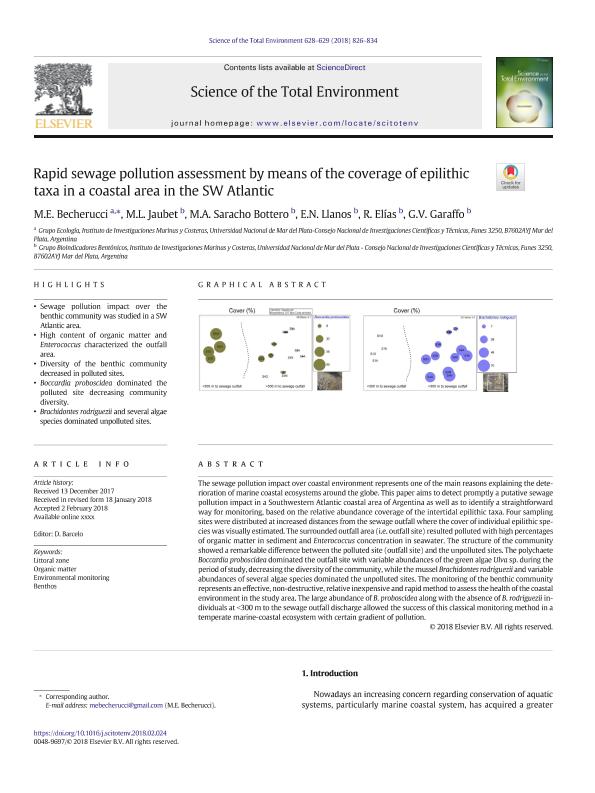Mostrar el registro sencillo del ítem
dc.contributor.author
Becherucci, Maria Eugenia

dc.contributor.author
Jaubet, Maria Lourdes

dc.contributor.author
Saracho Bottero, Maria Andrea

dc.contributor.author
Llanos, Elizabeth Noemi

dc.contributor.author
Elias, Rodolfo

dc.contributor.author
Garaffo, Griselda Valeria

dc.date.available
2019-10-31T18:55:07Z
dc.date.issued
2018-07
dc.identifier.citation
Becherucci, Maria Eugenia; Jaubet, Maria Lourdes; Saracho Bottero, Maria Andrea; Llanos, Elizabeth Noemi; Elias, Rodolfo; et al.; Rapid sewage pollution assessment by means of the coverage of epilithic taxa in a coastal area in the SW Atlantic; Elsevier Science; Science of the Total Environment; 628-629; 7-2018; 826-834
dc.identifier.issn
0048-9697
dc.identifier.uri
http://hdl.handle.net/11336/87757
dc.description.abstract
The sewage pollution impact over coastal environment represents one of the main reasons explaining the deterioration of marine coastal ecosystems around the globe. This paper aims to detect promptly a putative sewage pollution impact in a Southwestern Atlantic coastal area of Argentina as well as to identify a straightforward way for monitoring, based on the relative abundance coverage of the intertidal epilithic taxa. Four sampling sites were distributed at increased distances from the sewage outfall where the cover of individual epilithic species was visually estimated. The surrounded outfall area (i.e. outfall site) resulted polluted with high percentages of organic matter in sediment and Enterococcus concentration in seawater. The structure of the community showed a remarkable difference between the polluted site (outfall site) and the unpolluted sites. The polychaete Boccardia proboscidea dominated the outfall site with variable abundances of the green algae Ulva sp. during the period of study, decreasing the diversity of the community, while the mussel Brachidontes rodriguezii and variable abundances of several algae species dominated the unpolluted sites. The monitoring of the benthic community represents an effective, non-destructive, relative inexpensive and rapid method to assess the health of the coastal environment in the study area. The large abundance of B. proboscidea along with the absence of B. rodriguezii individuals at <300 m to the sewage outfall discharge allowed the success of this classical monitoring method in a temperate marine-coastal ecosystem with certain gradient of pollution.
dc.format
application/pdf
dc.language.iso
eng
dc.publisher
Elsevier Science

dc.rights
info:eu-repo/semantics/openAccess
dc.rights.uri
https://creativecommons.org/licenses/by-nc-nd/2.5/ar/
dc.subject
BENTHOS
dc.subject
ENVIRONMENTAL MONITORING
dc.subject
LITTORAL ZONE
dc.subject
ORGANIC MATTER
dc.subject.classification
Otras Ciencias de la Tierra y relacionadas con el Medio Ambiente

dc.subject.classification
Ciencias de la Tierra y relacionadas con el Medio Ambiente

dc.subject.classification
CIENCIAS NATURALES Y EXACTAS

dc.title
Rapid sewage pollution assessment by means of the coverage of epilithic taxa in a coastal area in the SW Atlantic
dc.type
info:eu-repo/semantics/article
dc.type
info:ar-repo/semantics/artículo
dc.type
info:eu-repo/semantics/publishedVersion
dc.date.updated
2019-10-24T19:03:31Z
dc.journal.volume
628-629
dc.journal.pagination
826-834
dc.journal.pais
Países Bajos

dc.journal.ciudad
Amsterdam
dc.description.fil
Fil: Becherucci, Maria Eugenia. Consejo Nacional de Investigaciones Científicas y Técnicas. Centro Científico Tecnológico Conicet - Mar del Plata. Instituto de Investigaciones Marinas y Costeras. Universidad Nacional de Mar del Plata. Facultad de Ciencias Exactas y Naturales. Instituto de Investigaciones Marinas y Costeras; Argentina
dc.description.fil
Fil: Jaubet, Maria Lourdes. Consejo Nacional de Investigaciones Científicas y Técnicas. Centro Científico Tecnológico Conicet - Mar del Plata. Instituto de Investigaciones Marinas y Costeras. Universidad Nacional de Mar del Plata. Facultad de Ciencias Exactas y Naturales. Instituto de Investigaciones Marinas y Costeras; Argentina
dc.description.fil
Fil: Saracho Bottero, Maria Andrea. Consejo Nacional de Investigaciones Científicas y Técnicas. Centro Científico Tecnológico Conicet - Mar del Plata. Instituto de Investigaciones Marinas y Costeras. Universidad Nacional de Mar del Plata. Facultad de Ciencias Exactas y Naturales. Instituto de Investigaciones Marinas y Costeras; Argentina
dc.description.fil
Fil: Llanos, Elizabeth Noemi. Consejo Nacional de Investigaciones Científicas y Técnicas. Centro Científico Tecnológico Conicet - Mar del Plata. Instituto de Investigaciones Marinas y Costeras. Universidad Nacional de Mar del Plata. Facultad de Ciencias Exactas y Naturales. Instituto de Investigaciones Marinas y Costeras; Argentina
dc.description.fil
Fil: Elias, Rodolfo. Consejo Nacional de Investigaciones Científicas y Técnicas. Centro Científico Tecnológico Conicet - Mar del Plata. Instituto de Investigaciones Marinas y Costeras. Universidad Nacional de Mar del Plata. Facultad de Ciencias Exactas y Naturales. Instituto de Investigaciones Marinas y Costeras; Argentina
dc.description.fil
Fil: Garaffo, Griselda Valeria. Consejo Nacional de Investigaciones Científicas y Técnicas. Centro Científico Tecnológico Conicet - Mar del Plata. Instituto de Investigaciones Marinas y Costeras. Universidad Nacional de Mar del Plata. Facultad de Ciencias Exactas y Naturales. Instituto de Investigaciones Marinas y Costeras; Argentina
dc.journal.title
Science of the Total Environment

dc.relation.alternativeid
info:eu-repo/semantics/altIdentifier/url/https://www.sciencedirect.com/science/article/pii/S0048969718304121
dc.relation.alternativeid
info:eu-repo/semantics/altIdentifier/doi/http://dx.doi.org/10.1016/j.scitotenv.2018.02.024
Archivos asociados
